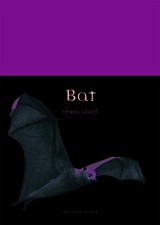2 books about Bat

Ball, Bat and Bishop
THE ORIGIN OF BALL GAMES
Robert W. Henderson
University of Illinois Press, 1947
Step aside, Abner Doubleday! In this impeccably researched history, Robert W. Henderson uncovers the true origins not only of baseball but of a score of related sports involving hitting, catching, throwing, or kicking a ball.
Henderson traces the origins of ball sports to religious rites in ancient Egypt, where the ball (perhaps a shrunken head) represented a fertility symbol and opposing teams engaged in mock combat signifying the struggle of good against evil. Centuries later, pagan fertility rites featuring the ball were adapted by the Christian church as rituals symbolic of Easter and the Resurrection. Court tennis was also firmly rooted in the church, the earliest players being the bishops, canons, and clerics who played it in their cloistered courtyards.
Henderson overturns the popular belief that the game of racquets originated in the debtors' prison on Fleet Street in the early nineteenth century. He also notes that polo, the most ancient of games played with stick and ball, originated in Persia and migrated to China and India, where it was eventually embraced by English imperialists. Other sports discussed include football, lawn tennis, cricket, and golf.
The most substantial portion of Henderson's study is devoted to the game of baseball. Providing copious evidence of early forms of baseball played in England and the United States before 1829, he offers a meticulous account of the legerdemain by which Abner Doubleday, the famous Civil War general, came to be identified as the inventor in 1839 of a game that was already at least two centuries old.
The new foreword by Leonard Koppett affirms the significance of this classic work of sports history, which was the first to dismantle the Doubleday/Cooperstown myth.
Henderson traces the origins of ball sports to religious rites in ancient Egypt, where the ball (perhaps a shrunken head) represented a fertility symbol and opposing teams engaged in mock combat signifying the struggle of good against evil. Centuries later, pagan fertility rites featuring the ball were adapted by the Christian church as rituals symbolic of Easter and the Resurrection. Court tennis was also firmly rooted in the church, the earliest players being the bishops, canons, and clerics who played it in their cloistered courtyards.
Henderson overturns the popular belief that the game of racquets originated in the debtors' prison on Fleet Street in the early nineteenth century. He also notes that polo, the most ancient of games played with stick and ball, originated in Persia and migrated to China and India, where it was eventually embraced by English imperialists. Other sports discussed include football, lawn tennis, cricket, and golf.
The most substantial portion of Henderson's study is devoted to the game of baseball. Providing copious evidence of early forms of baseball played in England and the United States before 1829, he offers a meticulous account of the legerdemain by which Abner Doubleday, the famous Civil War general, came to be identified as the inventor in 1839 of a game that was already at least two centuries old.
The new foreword by Leonard Koppett affirms the significance of this classic work of sports history, which was the first to dismantle the Doubleday/Cooperstown myth.
[more]

Bat
Tessa Laird
Reaktion Books, 2018
Bats have been maligned in the West for centuries. Unfair associations with demons have seen their leathery wings adorn numerous evil characters, from the Devil to Bram Stoker’s Dracula. But these amazing animals are ecological superheroes. Nectar-feeding bats pollinate important crops like agave; fruit-eating bats disperse seeds and encourage reforestation; and insect-eating bats keep down mosquito populations and other pests, saving agricultural industries billions of dollars. Ranging in size from a bumblebee to creatures with a wingspan the length of an adult human, found on all continents except Antarctica, and displaying extraordinary abilities like echolocation—a built-in sonar system that enables many bats to navigate in the dark—these incredibly diverse mammals are as surprising as they are misunderstood.
In Bat, Tessa Laird challenges our preconceptions as she combines fascinating facts of bat biology with engaging portrayals of bats in mythology, literature, film, popular culture, poetry, and contemporary art. She also provides a sobering reminder of the threats bats face worldwide, from heatwaves and human harassment to wind turbines and disease. Illustrated with incredible photographs and artistic representations of bats from many different cultures and eras, this celebration of the only mammals possessing true flight will enthrall batty fans, skeptics, and converts alike.
In Bat, Tessa Laird challenges our preconceptions as she combines fascinating facts of bat biology with engaging portrayals of bats in mythology, literature, film, popular culture, poetry, and contemporary art. She also provides a sobering reminder of the threats bats face worldwide, from heatwaves and human harassment to wind turbines and disease. Illustrated with incredible photographs and artistic representations of bats from many different cultures and eras, this celebration of the only mammals possessing true flight will enthrall batty fans, skeptics, and converts alike.
[more]
READERS
Browse our collection.
PUBLISHERS
See BiblioVault's publisher services.
STUDENT SERVICES
Files for college accessibility offices.
UChicago Accessibility Resources
home | accessibility | search | about | contact us
BiblioVault ® 2001 - 2024
The University of Chicago Press









